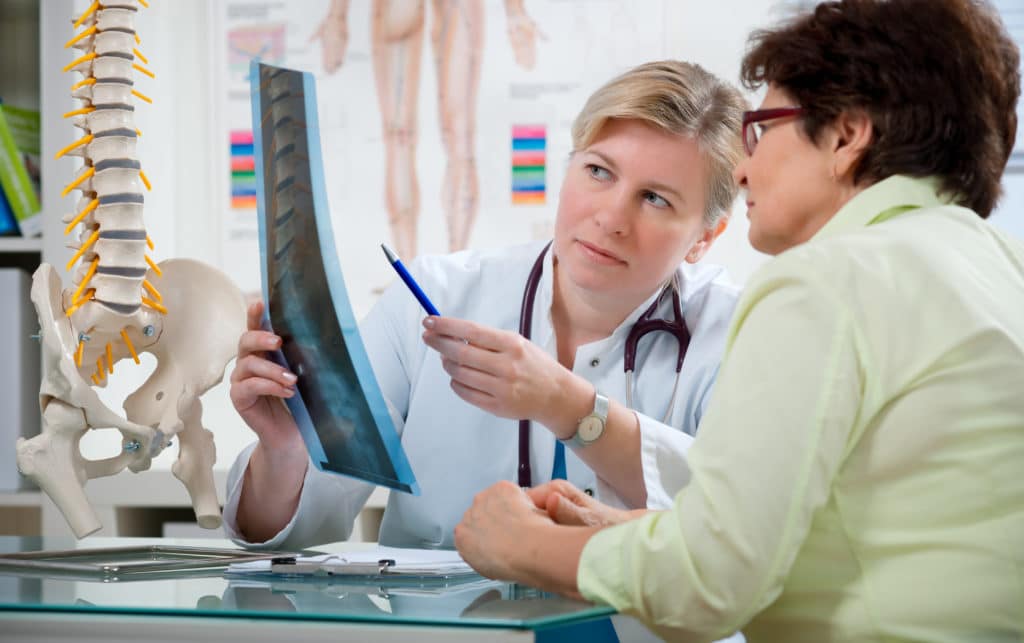Lumbar spinal stenosis is a common condition, affecting more than 200,000 adults in the United States. Lumbar spinal stenosis is the most common reason for spinal surgery in patients over the age of 65; however, surgery has shown no significant benefit over conservative treatment options. If you have recently received a diagnosis of lumbar spinal stenosis, conservative treatment options, including home treatment, may help to effectively manage your symptoms, helping you to avoid spinal surgery.
What is Lumbar Spinal Stenosis?
Lumbar spinal stenosis simply refers to spinal canal narrowing in the lumbar spine (lower back). This narrowing can lead to spinal cord and nerve root impingement, resulting in symptoms, including:
- Lower back pain.
- Pain, stiffness, weakness, cramping, and/or numbness in the lower extremities and/or buttocks.
- Decreased ability to perform physical activity requiring standing, walking or bending.
- Foot drop due to weakness in the legs or buttocks.
- Loss of sexual ability.
- Bowel and/or bladder incontinence.
While some individuals may have mild symptoms of lumbar spinal stenosis, others may have symptoms that come and go, that gradually worsen overtime.
Symptoms are typically worse with standing, walking, or bending backwards, and are relieved by lying down, sitting, or bending forward.
Causes of Lumbar Spinal Stenosis
There are various causes of lumbar spinal stenosis, many of which happen during the aging process including:
- Disc herniation.
- Bone spur development.
- Ligament thickening.
- Previous spinal surgery.
- Abnormally narrow spinal canal.
Diagnosis of Lumbar Spinal Stenosis
If your doctor suspects you have lumbar stenosis, they will likely perform a thorough physical examination that evaluates various things including muscle strength, sensation, flexibility, and reflexes. They may also order additional testing to further evaluate the spine, spinal cord, spinal nerves and surrounding structures including: X-ray, CT scan, MRI, bone scan, and/or electromyogram (EMG).
Conservative Treatment Options for Lumbar Spinal Stenosis
Self-treatment of lumbar spinal stenosis is focused on relieving symptoms of pain, weakness, and numbness, improving range of motion, and enhancing quality of life.
There are a number of home treatments that you can try to manage your symptoms including:
Ice and Heat Therapy
When your symptoms flare up, apply ice to the affected area for 10 to 15 minutes at a time to help decrease pain and inflammation. After the initial 48 hours, apply moist heat for 15 to 20 minutes at a time to help release muscle tension and pain.
Over-the-Counter (OTC) Medication
Using OTC medication, such as ibuprofen and naproxen, can help to decrease inflammation and pain. Check with your physician or pharmacist if you are unsure if you can take these types of medications.
Modifying Everyday Activities
When performing every day activities modify them so that your spine is positioned slightly forwards. Keeping your spine in a more comfortable position can help to relieve pressure on the spinal cord and nerves thereby helping to reduce symptoms.
Avoid sustained positions. Take frequent breaks.
Using Proper Posture
Using correct posture when sitting and standing can help to decrease pressure on the spine and associated nerves.
When standing ensure that your knees are slightly bent with your feet shoulder width apart and your weight evenly distributed over both feet. Make sure that your head is positioned over your neck and your shoulders are retracted back, not rolled forwards.
When sitting, position your buttocks against the back of the chair with your spine straight and shoulders back. Make sure your weight is distributed evenly over both hips with your knees at 90 degrees and your feet positioned flat on the floor. A small rolled up towel positioned in the small of your back can help to maintain the natural curve in your lower back.
Exercise
Exercise promotes blood flow, which helps to heal the body. It also strengthens the lower back muscles, helping to decrease pressure on the structures of the back. Additionally, it helps to maintain spinal flexibility, muscle activation, and prevent muscle tightness. Regular exercise helps maintain a healthy weight and physical conditioning.
Conclusion
Lumbar spinal stenosis is a common condition. If you are not experiencing worsening or severe muscle weakness and loss, conservative treatment bay be a better starting point for treatment. However, surgery has not been shown to produce significantly better outcomes than conservative treatment options. If you have been diagnosed with lumbar spinal stenosis, utilizing home treatment options including ice and heat therapy, OTC medications, activity modification, posture correction, and exercise can help to manage symptoms and improve your quality of life. If basic exercise does not relieve symptoms, see your physician and physical therapist for further guidance.
You can find more senior health resources including online fitness classes and prevention advice at the Physio Ed. website, PhysioEd.com “Active for a Lifetime.”
Resources
Lurie J, Tomkins-Lane C. Management of lumbar spinal stenosis BMJ 2016; 352 :h6234 doi:10.1136/bmj.h6234
Genevay S, Atlas SJ. Lumbar spinal stenosis. Best Pract Res Clin Rheumatol. 2010;24(2):253-265. doi:10.1016/j.berh.2009.11.001
Lafian AM, Torralba KD. Lumbar Spinal Stenosis in Older Adults. Rheum Dis Clin North Am. 2018 Aug;44(3):501-512. doi: 10.1016/j.rdc.2018.03.008. Epub 2018 Jun 12. PMID: 30001789.
https://orthoinfo.aaos.org/en/diseases–conditions/lumbar-spinal-stenosis/







